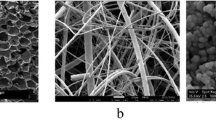Abstract
Heat transfer mechanisms in 14 samples of vacuum insulation panels (VIPs) are examined to reveal the influence of porous foam structure on VIP performance. The samples were produced by in-house equipment that was able to vary the foam structure by modulating the process temperature and pressure. Two parameters are proposed to describe the foam structure, namely, the broken cell ratio and the average cell size. Under a specific solid volume fraction, the average cell size shows a linear dependence on the broken cell ratio. Furthermore, the radiation and conduction heat transport data correlate well with these parameters. Radiation heat transfer increases as the broken cell ratio (cell size) increases, but solid conduction decreases as the broken cell ratio (cell size) increases. Consequently, an optimum broken cell ratio (cell size) exists such that the total heat transport is minimum under a specific solid volume fraction. However, the majority of VIP heat transfer is solid conduction. Solid conduction accounts for more than 80% of the total heat transport and is largely affected by the solid volume fraction. A rule of thumb for improving VIP performance is to reduce the solid volume fraction as much as possible to eliminate solid conduction, and maintain the cell size at an optimum value that is dependent on the solid volume fraction.









Similar content being viewed by others
Abbreviations
- d c :
-
cell size (μm)
- f s :
-
solid volume fraction (Vs/Vt)
- f s+g :
-
volume fraction of combined solid and gas
- i λ :
-
spectral intensity of radiation
- k s :
-
thermal conductivity of solid
- k s+g :
-
the equivalent thermal conductivity of combined solid and gas
- k r :
-
the thermal radiation conductivity
- k t :
-
the equivalent total thermal conductivity
- m :
-
the weight of the sample
- q s+g :
-
the heat flux of combined solid and gas
- q r :
-
radiation heat flux
- q t :
-
total heat flux
- T m :
-
the arithmetic mean of the boundary temperatures (K)
- V b :
-
the broken cell volume
- V s :
-
the volume of solid
- V s+g :
-
the volume of combined solid and gas in the unbroken cell
- V t :
-
the apparent volume (total volume)
- V tb :
-
the volume of all the cells
- V ub :
-
the volume of gas in the unbroken cell
- ρ f :
-
apparent density or foam density (kg m−3)
- ρ s :
-
the density of the solid, 991.96 (kg m−3)
- ρ s+g :
-
the density of the combined solid and gas in the unbroken cells (kg m−3)
- σ :
-
Stefan–Boltzmann constant, 5.67 × 10−8 W m−2 K−4
- σ e :
-
Rosseland mean extinction coefficient, Eq. (7)
- σ eλ :
-
spectral extinction coefficient, τ λ , spectral transmittance, Eq. (8)
- ϕ :
-
broken cell ratio, Vb/Vtb, Eq. (9)
References
Chu HS, Stretton AJ, Tien CL (1988) Radiative heat transfer in ultra-fine powder insulations. Int J Heat Mass Transf 31(8):1627–1634
Tseng CJ, Yamaguchit M, Ohmorit T (1997) Thermal conductivity of polyurethane foams from room temperature to 20 K. Cryogenics 37(6):305–312
Druma AM, Alam MK, Druma C (2004) Analysis of thermal conduction in carbon foams. Int J Thermal Sci 43:689–695
Giaretto V, Miraldi E, Ruscica G (1995/1996) Simultaneous estimations of radiative and conductive properties in lightweight insulating materials. High Temp High Press 27/28:191–204
Kuhn J, Ebert HP, Arduini-Schuster MC, Buttner D, Fricke J (1992) Thermal transport in polystyrene and polyurethane foam insulations. Int J Heat Mass Transf 35(7):1795–1801
Doermann D, Sacadura JF (1996) Heat transfer in open cell foam insulation. ASME J Heat Transf 118:88–93
Baillis D, Arduini-Schuster M, Sacadura JF (2002) Identification of spectral radiative properties of polyurethane foam from hemispherical and bi-directional transmittance and reflectance measurements. J Quant Spectrosc Radiat Transf 73:297–306
Glicksman LR, Torpey MR (1987) The influence of cell size and foam density on the thermal conductivity of foam insulation. Polyurethanes World Congress, Aachen, Germany. 29 September–2 October, pp 80–84
Glicksman LR, Marge AL, Moreno JD (1992) Radiation heat transfer in cellular foam insulation. ASME Paper HTD-203, Developments in Radiative Heat Transfer, pp 45–53
Kamiuto K (1997) Study of Dul’nev’s model for the thermal and radiative properties of open-cellular porous materials. JSME Int J Ser B 40(4):577–582
Placido E, Arduini-Schuster MC, Kuhn J (2005) Thermal properties predictive model for insulating foams. Infrared Phys Technol 46:219–231
Wu JW, Sung WF, Chu HS (1999) Thermal conductivity of polyurethane foams. Int J Heat Mass Transf 42:2211–2217
Caps R, Heinemann U, Fricke J, Keller K (1997) Thermal conductivity of polymide foams. J Heat Mass Transf 40(2):269–280
Coquard R, Baillis D (2006) Modeling of heat transfer in low-density EPS foams. ASME J Heat Transf 128:538–549
De Micco C, Aldao CM (2005) Radiation contribution to the thermal conductivity of plastic foams. J Polym Sci [B] 43:190–192
Zhao CY, Lu TJ, Hodson HP (2004) Thermal radiation in ultralight metal foams with open cells. Int J Heat Mass Transf 47:2927–2939
Zhao CY, Lu TJ, Hodson HP (2004) The temperature dependence of effective thermal conductivity of open-celled steel alloy foams. Mater Sci Eng A 367:123–131
Özisik MN (1973) Radiative transfer and interactions with conduction and convection. Wiley, New York
Quenard D, Giraud D (1998) Heat transfer in the packing of cellular pellets: microstructure and apparent thermal conductivity. High Temp High Press 30(6):709–715
Siegel R, Howell JR (2002) Thermal radiation heat transfer, 4th edn. Taylor & Francis, New York
Author information
Authors and Affiliations
Corresponding author
Rights and permissions
About this article
Cite this article
Tseng, PC., Chu, HS. An experimental study of the heat transfer in PS foam insulation. Heat Mass Transfer 45, 399–406 (2009). https://doi.org/10.1007/s00231-008-0417-1
Received:
Accepted:
Published:
Issue Date:
DOI: https://doi.org/10.1007/s00231-008-0417-1




